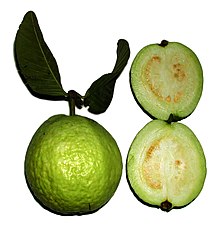**Guava Types and Characteristics**:
– The most common species is the apple guava (Psidium guajava).
– Guavas belong to the Myrtoideae family with tough dark leaves and white flowers.
– Guava fruits are many-seeded berries, and leaves are opposite, simple, and elliptic to ovate.
– Fruit sizes range from 4 to 12 centimeters, with varying skin thickness and pulp color.
**Guava Etymology and Origin**:
– The term ‘guava’ originated from the Taíno word ‘guayabo’ for the guava tree.
– The name has been adapted in various languages and has a similar form in Spanish as ‘guayaba’.
– Guavas are believed to have originated from regions spanning Mexico, Central America, and northern South America.
– Evidence of guava cultivation dates back to 2500 BCE in Peru, and guavas are now grown in subtropical and tropical regions globally.
**Guava Production and Distribution**:
– In 2019, global guava production reached 55 million tonnes, with India leading at 21.8 million tonnes.
– India accounts for 45% of total guava production, followed by China and Thailand as major producers.
– Guavas were introduced to Florida in the 19th century and are grown in various tropical and subtropical countries.
**Guava Uses and Nutritional Benefits**:
– Guavas are rich in carbohydrates, fiber, vitamins, and minerals, making them a nutritious fruit.
– They are used in beverages, sauces, candies, preserves, and desserts, and guava juice is popular in many countries.
– Guava’s high pectin content is utilized in making candies, preserves, and jams, while it can also be used as a base in salted products.
**Guava Health Benefits and Concerns**:
– Guava leaves contain carotenoids and polyphenols, with different varieties having varying phytochemical content.
– Guava seed oil is rich in linoleic acid, beneficial for skin and hair health, and is used in culinary and cosmetic products.
– Guavas have been studied in folk medicine for their medicinal potential, with research focusing on therapeutic applications.
– Guavas are susceptible to parasites like fruit flies and fungal pathogens, which can impact production and quality, necessitating control measures.
Guava (/ˈɡwɑːvə/ GWAH-və) is a common tropical fruit cultivated in many tropical and subtropical regions. The common guava Psidium guajava (lemon guava, apple guava) is a small tree in the myrtle family (Myrtaceae), native to Mexico, Central America, the Caribbean and northern South America. The name guava is also given to some other species in the genus Psidium such as strawberry guava (Psidium cattleyanum) and to the pineapple guava, Feijoa sellowiana. In 2019, 55 million tonnes of guavas were produced worldwide, led by India with 45% of the total. Botanically, guavas are berries.



